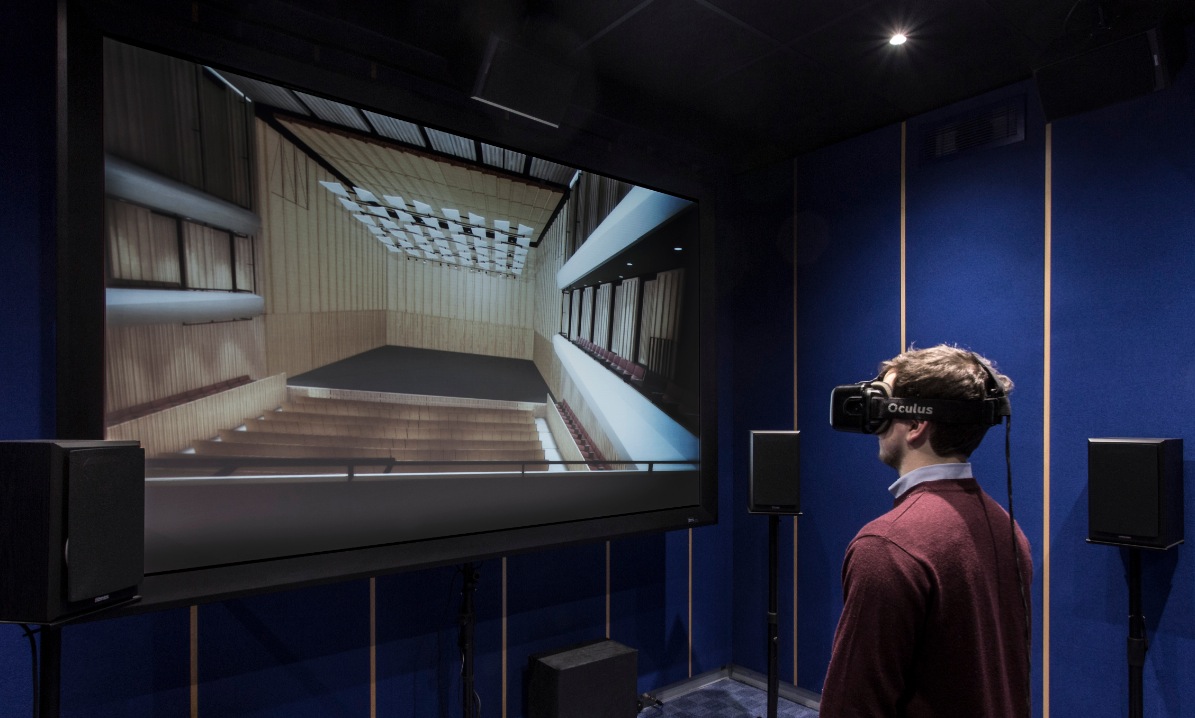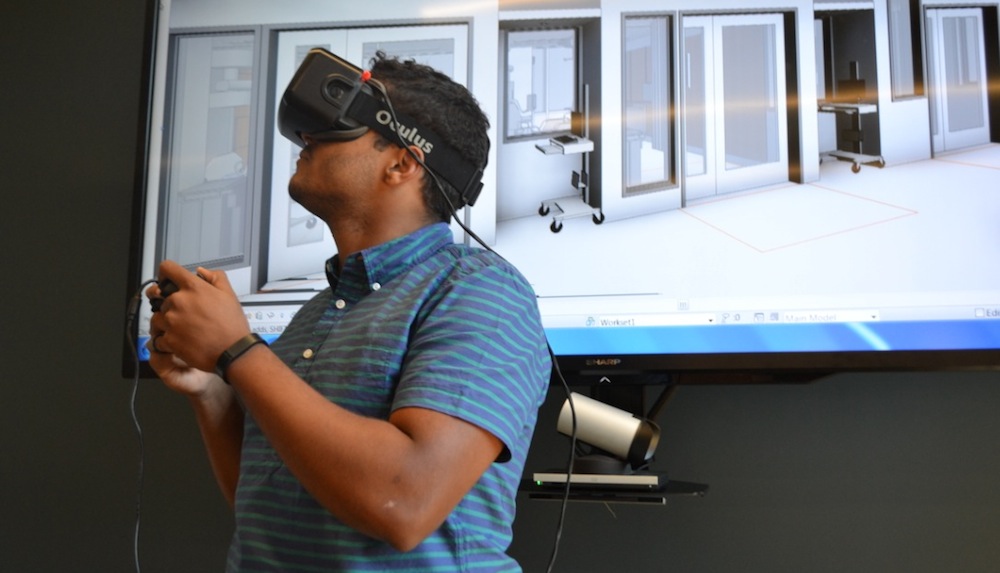If a picture, or in this case, a rendering, is worth a thousand words, then how many words would a 3D virtual tour be worth? The answer: more than a thousand. A lot more. It’s like comparing “The Cat in the Hat” to “The Count of Monte Cristo.” And with advances in technology, this route of 3D virtual tours created using gaming engines appears to be the wave of the future when it comes to designing buildings.
An image or rendering, regardless of how photorealistic it may be, just can’t provide the same experience as throwing on an Oculus Rift, Samsung Gear VR, or Google Cardboard and actually placing a client in their new building before a single ounce of concrete has been poured.
A major obstacle that Building Teams face when looking to implement VR gaming on projects is turnaround time. The process of converting a BIM file to a realistic gaming environment could take days, even weeks, bringing the design workflow to a screeching halt. This conundrum has software developers scrambling to create streamlined BIM-to-gaming solutions that cater to the masses with faster turnaround times, improved quality, and enhanced user experience.
Shannon Lightfoot, BIM manager with McCarthy Building Companies, says the firm’s Southeast Division has been able to compress the turnaround time on VR models to just a few hours—at most, a few days, for models that call for a higher level of detail. After a BIM/VDC model is completed, the McCarthy team shares it via the cloud with third-party provider VIMtrek, which renders the model using the Unity game engine. Once rendered, VIMtrek provides a link that offers one-click access to a detailed, highly interactive walkthrough environment that can be navigated using a computer, mobile device, or VR headset.
“Once the visual information model is returned to us, we pull it up on a Samsung Galaxy smartphone, which is inserted into the Gear VR headset,” says Lightfoot.
Depending on the level of service, the VIMtrek rendering process takes between three hours (fast-track option) and 10 hours (standard service). This is among the industry’s fastest turnaround times.
McCarthy has incorporated this emerging technology, whether with VIMtrek or another third-party company, into numerous projects, including Emory University Hospital’s new 400,000-sf J Wing and a project involving the Community Regional Medical Center, Fresno, Calif.
 Tony Trup, an Acoustic Consultant with Arup, explores a concert hall design using the firm’s VR-enabled Soundlab. The studio allows users to experience the visuals and acoustics of a given seat within a performing arts space. Photo: ARUP. Click photo to enlarge.
Tony Trup, an Acoustic Consultant with Arup, explores a concert hall design using the firm’s VR-enabled Soundlab. The studio allows users to experience the visuals and acoustics of a given seat within a performing arts space. Photo: ARUP. Click photo to enlarge.
GAMING FOR THE MASSES
The term “virtual reality” still carries a bit of weight for many people who think it comes at an exorbitant cost. But remember, we’re living in the future. VR no longer consists of a giant headset connected to an even larger computer that makes users look like they’re plugged into the matrix. Thanks to Samsung Gear VR and the even more inexpensive Google Cardboard, any architect, engineer, designer, or client with a smartphone can walk through a building that hasn’t even been built yet.
This capability provides enormous benefits. Renderings can give someone an idea of what to expect, but they can’t compete with actually being able to walk through an environment that is still on the drawing board. A VR tour can make spacing issues or ways to improve functionality of a given space much more apparent.
TRENDS TAKING AEC GAMING TO NEW HEIGHTS
1] Faster turnaround. BIM-to-game turnaround times are dramatically shrinking, from days to hours.
2] Bringing VR in house. Many firms have hired individuals from outside the traditional BIM career path to focus on the graphical representation of models.
3] Bypassing gaming engines. While gaming engines dominate the landscape, some companies are looking to forego them altogether. Software that does not require a gaming engine to produce similar results, like that offered by IrisVR, can further increase the speed of model export.
4] Supporting collaboration. Better quality without decreased transfer times, haptic feedback, and high-end telepresence (sharing the same space with another person with a high level of realism) are all possibilities in the not too distant future.
5] The rise of ultra-immersive models. Some Building Teams, including luxury condo developers, are investing in photorealistic, highly interactive VR models that allow users (potential buyers) to, for instance, open doors, turn on the lights, and change materials.
“What’s powerful about VR is that it gives a sense of scale, especially ceiling height, long before construction,” says Terence Caulkins, Senior Acoustics and Audio Visual Consultant with Arup. “Even a 3D model spinning around on a monitor does not give the feeling of being there, which is the key, novel benefit of VR.” Don’t forget, this important, novel benefit is being made available quicker than ever before.
The alternative is not discovering these problems until much later in the project, something that can cost a lot of time and money. “The time, effort, and physical costs to change something in the field is typically five to 10 times that of doing it right the first time,” says Lightfoot.
MULTIPLE COMPANIES, MULTIPLE ENGINES
Not only do the third-party companies differ, but the gaming engines used differ, as well. And each gaming engine offers various pros and cons.
“We’ve explored Unity 3D, Unreal Engine, and Revizto,” says Lightfoot. “Revizto is streamlined compared to Unreal, with a quicker import process. But it still requires wait time for light baking. Unreal requires specific breakdown of building components for lightmap set up prior to calculating.”
Each option must be weighed against the specific needs of the project.
Arup also uses VR technology and gaming engines on many of its projects. “In the last few years, we have started incorporating VR into our SoundLab demonstrations,” says Caulkins. The most recent example is a virtual tour of the Stormen concert hall in Bodo, Norway. “In this demonstration you are able to experience the acoustics and visuals of the room from different seats in the hall, in different conditions,” he says. As Arup has shown, VR can stretch far beyond just a visual tour and engage other senses as well.
Other companies, such as IVR Nation, have gone with other gaming engines (in this case, Unreal Engine 4) that can offer greater detail and photorealism at the expense of a quick turnaround. Olivier Demangel, the company’s Founder and Design Director, says it takes about “one week for a basic model to three months if you need a detailed photorealistic VR experience with interactivity like opening the door, turning on the lights, and changing the materials.”
In most cases, interactive aspects like being able to open doors or turn on lights aren’t sufficiently necessary to warrant a three-month turnaround. But there are instances where it could prove useful, such as with a luxury apartment complex or resort—places where the details are the defining aspect of a project that hasn’t figured out all of its funding yet. If clients need a little convincing to open up their checkbooks, a high level of detail outweighs a quick turnaround.
“For example, if a client’s expectation is to raise funds for the project, a photorealistic and immersive VR experience is required,” says Lightfoot. “If the client’s expectation is to accomplish quick coordination of building systems, then VR quality is a lower priority over something like accuracy.”
But many times, clients, architects, and designers favor a quick turnaround to hyper-realistic graphics.
“Responsiveness is key to successfully using VR,” adds Lightfoot. “No one will wait around for something to be done with a new technology that has a more traditional solution.”
VR HAS ITS DEFICIENCIES, BUT THEY’RE BEING ADDRESSED
Gaming technology is not without its shortcomings, but many of the flaws are quickly being attended to by the gaming industry.
“The biggest shortcoming is portability, though this is becoming less of an issue as the hardware to run and interact in VR is getting smaller and requiring less horsepower,” says Lightfoot. Another weakness: establishing collaboration in a VR environment. “Ideally, you want an entire team to interact in VR, not just one person who is in control,” he says.
Arup views the technology’s fledgling state as its biggest source of shortcomings. “At this point, many of the VR headsets are developer kits, and have inherent bugs that need to be ironed out,” says Anthony John Cortez, Senior Designer at Arup. “Latency, resolution, frame rate, field of view (particularly in AR) are all issues that currently exist. We expect to see great improvements in VR quality this year, as consumer-version headsets hit the video game market.”
Technologies such as unmediated VR technologies like holographic displays and more readily available BIM caves that enable users to experience VR without wearing anything are completely possible and plausible next steps for the industry, according to Caulkins.
Virtual reality and video games are no longer just about having a good time rescuing Princess Peach; they have become a vital, and quickly evolving, tool for the AEC market. The faster these VR tours can be created from a BIM model or rendering, the more helpful they will become.
Related Stories
BIM and Information Technology | May 8, 2023
BIM Council seeks public comments on BIM Standard-US Version 4
The Building Information Management (BIM) Council is seeking public comment on an updated national BIM standard. NBIMS-US V4 has been three years in the making and is scheduled to be released this fall.
Digital Twin | May 8, 2023
What AEC professionals should know about digital twins
A growing number of AEC firms and building owners are finding value in implementing digital twins to unify design, construction, and operational data.
BIM and Information Technology | May 8, 2023
3 ways computational tools empower better decision-making
NBBJ explores three opportunities for the use of computational tools in urban planning projects.
Sustainability | May 1, 2023
Increased focus on sustainability is good for business and attracting employees
A recent study, 2023 State of Design & Make by software developer Autodesk, contains some interesting takeaways for the design and construction industry. Respondents to a survey of industry leaders from the architecture, engineering, construction, product design, manufacturing, and entertainment spheres strongly support the idea that improving their organization’s sustainability practices is good for business.
Sustainability | Apr 20, 2023
13 trends, technologies, and strategies to expect in 2023
Biophilic design, microgrids, and decarbonization—these are three of the trends, technologies, and strategies IMEG’s market and service leaders believe are poised to have a growing impact on the built environment.
Urban Planning | Apr 17, 2023
The future of the 20-minute city
Gensler's Stacey Olson breaks down the pros and cons of the "20-minute city," from equity concerns to data-driven design.
Intelligent Lighting | Feb 13, 2023
Exploring intelligent lighting usage in healthcare, commercial facilities
SSR's Todd Herrmann, PE, LEEP AP, explains intelligent lighting's potential use cases in healthcare facilities and more.
AEC Tech | Jan 27, 2023
Epic Games' latest foray into the AEC market and real estate industry
From architecture to real estate, the realm of computer-aided design hits new heights as more and more firms utilize the power of Epic Games’ Twinmotion and Unreal Engine.
AEC Tech | Jan 27, 2023
Key takeaways from Autodesk University 2022
Autodesk laid out its long-term vision to drive digital collaboration through cloud-based solutions and emphasized the importance of connecting people, processes and data.
Digital Twin | Nov 21, 2022
An inside look at the airport industry's plan to develop a digital twin guidebook
Zoë Fisher, AIA explores how design strategies are changing the way we deliver and design projects in the post-pandemic world.


















